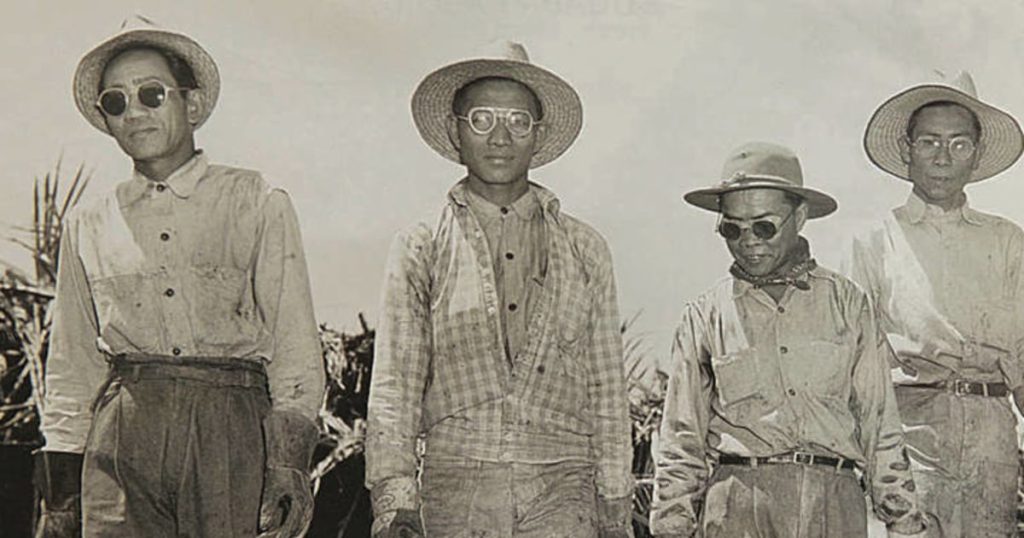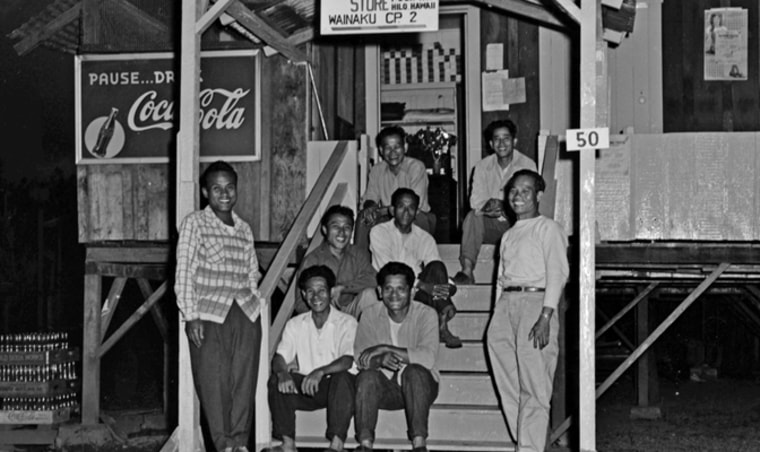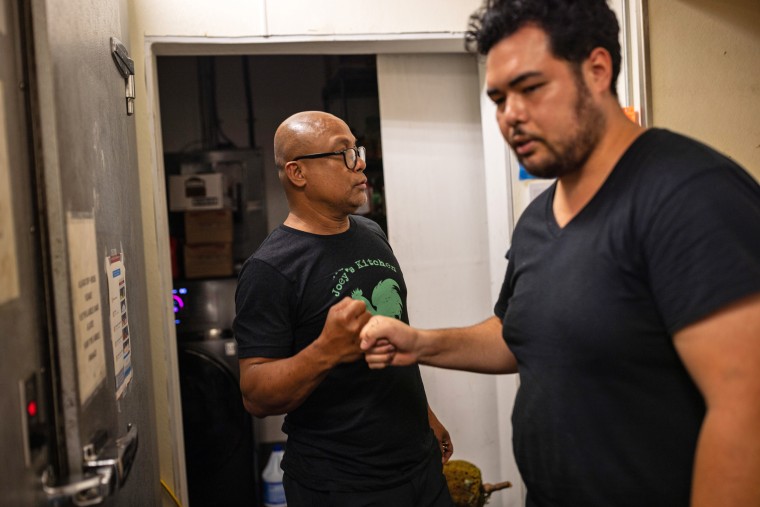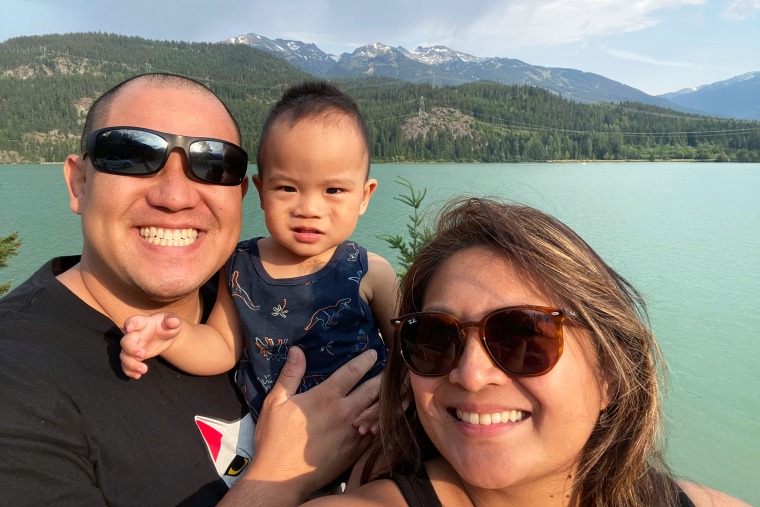
When Debbie Arellano, 37, first saw the smoke, she grabbed what little she could from her studio unit and fled with her 18-month-old baby. As she drove out of Lahaina, Hawaii, praying her mom and cousins weren’t too far behind, she worried about her family’s future — and that of her Filipino community at large. She said she knew that the toll would be disproportionate.
In the weeks since the blaze, she has been bounced around among hotels, she has seen immigrant relatives’ confusion as they struggle to fill out English-only aid forms, and she has watched as her community’s distrust of institutions grows.
Members of the affected Filipino community say they face unique challenges, including the toll of continuing to work in the tourism industry, the inability to access aid because of language and immigration status and financial challenges tied to their multigenerational households.
Filipinos make up about 25% of the population in Hawaii as the second-largest racial group in the state, according to the 2020 census. They make up an even larger share in Lahaina, the town most severely affected by the fires, at 40%, and they constitute a disproportionate segment of the workers in the tourism industry.
And many of their stories still remain in the shadows, they fear. Filipinos are the largest undocumented population in the state, making up 46% of the population.

“We have systems in place to take care of each other,” Arrelano said. “We’ve always taken care of each other.”
With multigenerational families split up, trying to afford individual rentals with money they once pooled with their relatives, Arellano questions the U.S. government’s definition of a household.
“I’ve heard stories of families not being able to find rentals because landlords are not willing to accommodate so much as seven people in a housing unit,” she said. “Immigrant families are having to split up in order to find a rental but are unable to afford the rental because they were only able to afford living in Lahaina by squeezing in a house together and pooling their service industry wages in order to afford rent.”
Filipino immigrants have a long history on the archipelago, according to the University of Hawaii. In the decades before Hawaii became a state in 1959, American corporations dominated the U.S. territory. Seeking low-cost laborers to work their sugar cane plantations, the corporations would recruit men, known as sakadas, from the Philippines to bring to Hawaii in the early 1900s.
The workers faced harsh conditions and exploitation and were often paid little to nothing for their labor, which fueled an economic boom in Hawaii. But many Filipino families put down deep roots on the island, and the population has continued to boom, with thousands of immigrants from the Philippines still coming to Hawaii each year.
Lahaina, in particular, is considered a Filipino enclave, with many working-class families, especially those involved in the tourism industry, living in the area, said Khara Jabola-Carolus, a co-founder of and volunteer with the Maui-based immigrant rights organization Roots Reborn, who is of Filipino descent.

Maui-based immigration attorney Kevin Block said he has been “in the trenches” with his clients since the fires. His clients have told him harrowing personal accounts, including stories of multigenerational families packed into single cars and grandparents fleeing the flames on foot. And as the panic of getting out gave way to the scramble of getting help, he said, Filipino immigrants have had a particularly rough time. Many lost not just homes and family but also vital documentation, like their green cards, visa information and Philippines passports. Recovering those isn’t always easy, he said. An obvious challenge was language access.
“There was a lot of confusion directly when the event was occurring, and some of the information that came out immediately afterwards was definitely all in English,” he said.
Government agencies like Citizenship and Immigration Services, which handles immigration paperwork, offer forms only in English, which compounded the confusion, he said.
“Of all the agencies that you would think would translate their documents into other languages, it would be them, but they don’t,” he said. “And the forms are confusing.”
Citizenship and Immigration Services said it is making efforts to support immigrants in Maui after the fires, including distributing flyers in multiple languages to promote a free legal clinic.
Roughly 59% of Filipinos in Hawaii are non-English-speaking at home. Community groups have led the charge in getting documents translated into Spanish and Tagalog. Others have also helped organize translators for Ilocano, another language that is particularly common among immigrants in Lahaina, spoken in the Ilocos region of the Philippines, where men had historically been recruited to work on plantations in Hawaii.

While some are having difficulty navigating the decentralized sources of aid, Jabola-Carolus said, many others who are undocumented are actively avoiding government help. She said many have a deep distrust of federal and state agencies, while others also fear jeopardizing their lives in Hawaii or those of loved ones who are also of undocumented status. The Federal Emergency Management Agency, Jabola-Carolus added, is a sister agency of Immigration and Customs Enforcement, both of which are under the Department of Homeland Security.
“You can’t expect people to believe that their hunter is their helper suddenly. … You can’t expect them to believe that the government who is trying to weed them out and deport them is now a source of refuge,” Jabola-Carolus said. “There are Filipino victims of the fires who are actively trying to hide from help.”
Neither Immigration and Customs Enforcement nor the Department of Homeland Security responded to requests for comment. But FEMA spokesperson told NBC News that regardless of immigration status, “any disaster survivor is entitled to short-term, non-cash, in-kind federal emergency disaster relief programs” and that non-citizens will not be referred for removal.
Regardless of people’s statuses, distrust is common, Block said, and it makes them less likely to seek help. With organizations like FEMA asking for DNA samples, the anxiety was heightened.
Cathy Betts, the director of the state’s Department of Human Services, who has also been on the ground with her mother translating for Filipino immigrants, said the fire’s impact on the tourism industry has left many Filipino immigrants anxious about the recovery process.

Recovering from the fires can feel like an uphill battle for many families, Betts said. But she said she sees a need for “cultural navigators” on the ground who could help demystify the various forms of aid, build trust with community members and help those in the tourism industry and beyond secure help if they need it.
“Their tourism industry is going to be devastated. … In the coming months, their economy is going to be disparaged, and they’re going to have to pick up other jobs, so it was very clear to me that people are starting to panic,” she said.
In some cases, Betts said, she has encountered Filipino hotel workers who have continued to head to their jobs in the hotels every day, despite having been displaced, eager for visitors to contribute to the economy.
“If folks are busy back at work, God bless them, but if they need to have some resources to help them or have some respite, that needs to be there, as well,” Betts said.
An effective recovery, experts say, will mean ensuring that the Filipino community is integral to the decision-making efforts.
“We are actually invisible,” Jabola-Carolus said. “If Filipinos aren’t at the table, locked arm in arm with Native Hawaiians, then none of this is guaranteed to actually heal the community.”

 Latest Breaking News Online News Portal
Latest Breaking News Online News Portal




